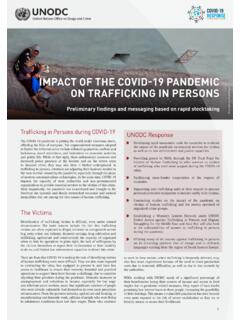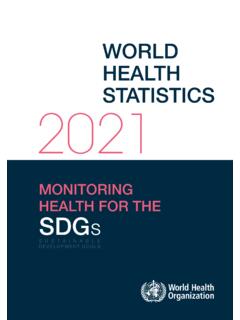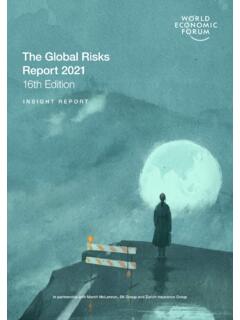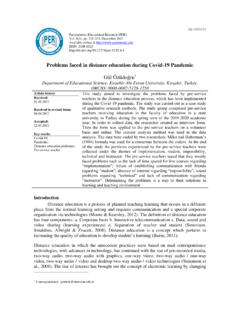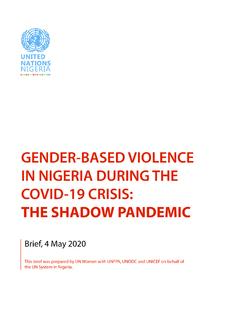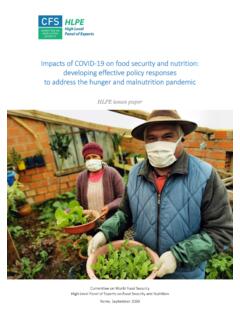Transcription of The Impact of COVID-19 on Women - United Nations
1 Policy Brief:The Impact of COVID-19 on Women 9 APRIL 2020 POLICY BRIEF: THE Impact OF COVID-19 ON Women 3 2 POLICY BRIEF: THE Impact OF COVID-19 ON WOMENThe year 2020, marking the twenty-fifth anniversary of the Beijing Platform for Action, was intended to be ground-break-ing for gender equality. Instead, with the spread of the COVID-19 pandemic even the limited gains made in the past decades are at risk of being rolled back. The pandemic is deepening pre-existing inequalities , exposing vulnerabilities in social, political and economic systems which are in turn amplifying the impacts of the pandemic . Across every sphere, from health to the economy, security to social protection, the impacts of COVID-19 are exacerbated for Women and girls simply by virtue of their sex: >Compounded economic impacts are felt especially by Women and girls who are gen-erally earning less, saving less, and holding insecure jobs or living close to poverty.
2 >While early reports reveal more men are dying as a result of COVID-19 , the health of Women generally is adversely impacted through the reallocation of resources and priorities, including sex-ual and reproductive health services. >Unpaid care work has increased, with children out-of-school, heightened care needs of older persons and overwhelmed health services. >As the COVID-19 pandemic deepens eco-nomic and social stress coupled with restricted movement and social isolation measures, gender-based violence is increasing exponentially. Many Women are being forced to lockdown at home with their abusers at the same time that services to support survivors are being disrupted or made inaccessible. >All of these impacts are further ampli-fied in contexts of fragility, conflict, and emergencies where social cohesion is already undermined and institutional capacity and services are limited.
3 This policy brief focuses on each of these issues in turn, exploring how Women and girls lives are changing in the face of COVID-19 , and outlining suggested priority mea-sures to accompany both the immediate response and longer-term recovery efforts. COVID-19 is not only a challenge for global health systems, but also a test of our human spirit. Recovery must lead to a more equal world that is more resilient to future crises. Fiscal stimulus packages and emergency measures to address public health gaps have been put in place in many countries to mitigate the impacts of COVID It is crucial that all national responses place Women and girls - their inclu-sion, representation, rights, social and economic outcomes, equality and protection - at their centre if they are to have the necessary impacts. This is not just about rectifying long-standing inequalities but also about building a more just and resilient world.
4 It is in the interests of not only Women and girls but also boys and men. Women will be the hardest hit by this pandemic but they will also be the backbone of recovery in communities. Every policy response that rec-ognizes this will be the more impactful for it. To achieve this, the policy brief empha-sizes three cross-cutting priorities: 1) ENSURE Women S EQUAL REPRESENTATION IN ALL COVID-19 RESPONSE PLANNING AND DECISION-MAKING. Evidence across sectors, including economic planning and emergency response, demonstrates unques-tioningly that policies that do not consult Women or include them in decision-making are simply less effective, and can even do harm. Beyond individual Women , Women s organizations who are often on the front line of response in communities should also be represented and supported. 2) DRIVE TRANSFORMATIVE CHANGE FOR EQUALITY BY ADDRESSING THE CARE ECONOMY, PAID AND UNPAID: In the for-mal economy care jobs, from teachers to nurses, are underpaid in relation to other sectors.
5 In the home, Women perform the bulk of care work, unpaid and invisible. Both are foundational to daily life and the economy but are premised on and entrench gendered norms and inequalities . 3) TARGET Women AND GIRLS IN ALL EFFORTS TO ADDRESS THE SOCIO-ECONOMIC Impact OF COVID-19 . It will be important to apply an intentional gender lens to the design of fiscal stimulus packages and social assis-tance programmes to achieve greater equal-ity, opportunities, and social protection. These three cross-cutting priorities reflect the Secretary-General s recent Call to Action on Human Rights, which singled out mea-sures that, if pursued, would have mean-ingful Impact on the rights of Women and girls. These measures have become more vital in the context of the DESA Policy Brief #58, COVID-19 : Addressing the social crisis through fiscal stimulus plans , BRIEF: THE Impact OF COVID-19 ON Women 5 4 POLICY BRIEF: THE Impact OF COVID-19 ON WOMENI.
6 Economic Impactsliving in poverty. For those who, as a result of recent economic growth managed to escape from extreme poverty, they are likely to fall back into this most vulnerable of situations once Recovery MeasuresEverything we do during and after the COVID-19 crisis must aim to build more equal, inclusive and sustainable economies and societies. This is perhaps the clearest lesson emerging from the pandemic . This includes gender-re-sponsive economic and social policies and placing Women s economic lives at the heart of the pandemic response and recovery plans. As of March 31, 65 countries had passed fis-cal response packages equivalent to a total of US$ A total of 106 countries had introduced or adapted social protection and jobs programs in response to COVID-19 by April Within these packages, social assis-tance (non-contributory transfers) is the most widely used tool, followed by social insurance and supply-side labor market interventions.
7 It is important for these interventions to incor-porate sex disaggregated data, a gender lens and specific targeting of Women . For example, cash-transfer programs are the most widely used social assistance intervention. Sectors where Women are a large proportion of workers, and where supply chains have been disrupted, should have adequate access to credit, loans, grants so they can retain the female work force. Similarly, disbursement procedures need to take into account Women and girls care obligations and possible informal status in their employ-ment to make benefits accessible to them. Beyond this, the whole range of economic policies for both immediate response and long-term recovery need to be designed and implemented with a gender lens. This includes removal of barriers that prevent full involvement of Women in economic activi-ties, equal pay and equal opportunities, social protection schemes that factor in existing biases, financing for Women entrepreneurs and mechanisms to promote Women s self-em-ployment.
8 Such economic responses would include both the public and private , narrowing gender-based education gaps and ensuring Women remain in and expand their participation in the formal labour market will play a significant role in providing many econo-mies with the capacity to rebound with stron-ger, more equitable and sustainable , current social protection systems are not wide enough. Many Women will not have access as safety nets frequently depend on formal par-ticipation in the labor force. In South Asia, over 80 percent of Women in non-agricultural jobs are in informal employment; in sub-Saharan Africa this figure is 74 percent; and in Latin America and the Caribbean 54 percent of Women in non-agricultural The Impact of COVID-19 across the global econ-omy will be profound. Already, as described in greater detail in the policy brief Shared respon-sibility, global Solidarity on the socioeconomic impacts of COVID-19 , markets and supply chains have been disrupted, businesses are required to close or scale back operations, and millions have or will lose their jobs and ILO has estimated that full or partial lockdown measures now affect almost billion workers, represent-ing around 81% of the world s workforce, while the IMF projects a significant contraction of global output in COVID-19 is lurching the world economy towards a global recession, which will be strikingly different from past Emerging evidence on the Impact of COVID-19 suggests that Women s economic and produc-tive lives will be affected disproportionately and differently from men.
9 Across the globe, Women earn less, save less, hold less secure jobs, are more likely to be employed in the informal sector. They have less access to social pro-tections and are the majority of single-parent households. Their capacity to absorb economic shocks is therefore less than that of men. As Women take on greater care demands at home, their jobs will also be disproportionately affected by cuts and lay-offs. Such impacts risk rolling back the already fragile gains made in female labor force participation, limiting Women s ability to support themselves and their families, especially for female-headed households. In many countries, the first round of layoffs has been particularly acute in the services sector, including retail, hospitality and tourism, where Women are overrepresented. The situation is worse in developing economies where the vast majority of Women s employ-ment 70 per cent is in the informal econ-omy with few protections against dismissal or for paid sick leave and limited access to social protection.
10 To earn a living these work-ers often depend on public space and social interactions, which are now being restricted to contain the spread of the The Ebola virus showed that quarantines can significantly reduce Women s economic and livelihood activities, increasing poverty rates, and exacerbating food In Liberia where approximately 85 per cent of daily market traders are Women , Ebola prevention measures (which included travel restrictions) severely impacted Women s livelihoods and economic Moreover, while men s economic activity returned to pre-crisis levels shortly after preventative measures subsided, the impacts on Women s economic secu-rity and livelihoods lasted much longer. From past experience and emerging data, it is possible to project that the impacts of the COVID-19 global recession will result in a prolonged dip in Women s incomes and labor force participation, with compounded impacts for Women already 2 Shared Responsibility, global Solidarity: Responding To The Socio-Economic Impacts Of COVID-19 March 2020 IMF, add refs [The IMF will release its global economic outlook only on 14 April]4 #651eba9a28e65 Globally, informal employment is a greater source of employment for men ( per cent) than for Women ( per cent), but in low and lower-middle income countries, a higher proportion of Women are in informal employment than men.










